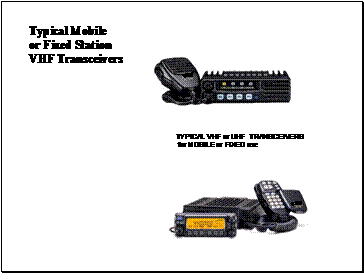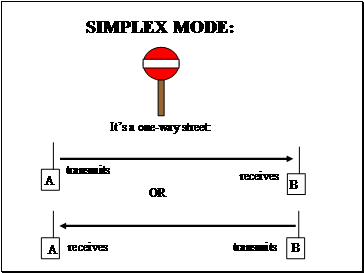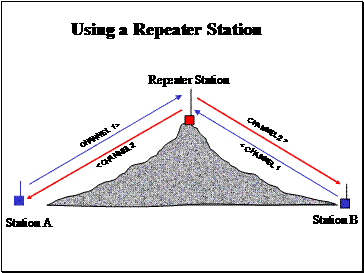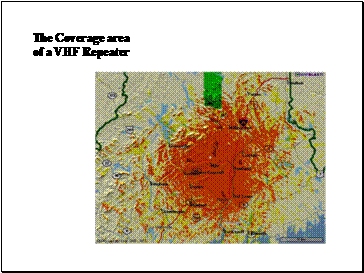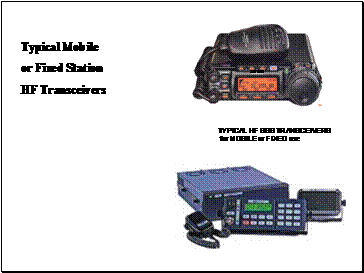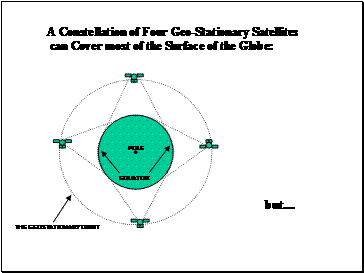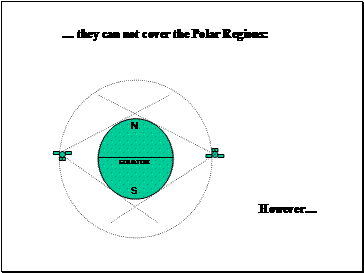Illustration 3.1
The « walky-talky » is a personal telecommunication tool for the individual user. With accessories, such as a separate microphone or an antenna with higher performance, the hand-held transceiver can be adapted to special requirements.
Indispensable accessories are battery chargers for use either on the power line or with connection to the battery of a vehicle. Institutional emergency services, such as police or fire fighters, prefer chargers capable to charge several batteries at their base; if the user needs the radio permanently, it is usually more convenient to issue individual chargers. The chargers should in any case be able to also charge batteries alone, without the radio. This way, charged spare batteries will be available for quick exchange.
The transceivers in the picture are all equipped with very short antennas. These are most convenient for short distance communication. A wider range can only be achieved if a longer antenna is used.
Illustration 3.2
VHF transceivers for mobile or fixed use are about the size of a car radio. They have higher power than hand-held transceivers and their antennas, usually mounted on the roof of a vehicle, are of higher performance.
The lower picture shows a mobile transceiver with a separate « control head ». This configuration allows the installation of the controls in a location convenient for the user, while the actual radio can be placed wherever space is available. It also includes a microphone with a keyboard, allowing the control of some of the transceiver's functions without the need to access the radio or control panel itself.
Mobile equipment is normally powered from the car battery. In fixed installations, a battery and a charger are the better solution than a power supply providing 12 Volt DC from the power line: In case of loss of line power, a charged battery will allow the radio to operate without interruption. A so called « intelligent charger » can remain connected permanently to power line and battery without the risk of overcharging, as it reduces the charging current automatically, once the battery is fully charged.
Illustration 3.3
VHF and UHF networks usually operate in simplex mode. At any given time, each station can either receive or transmit. Stations indicate the end of their transmission, usually with the word « OVER » (meaning «over to you»), thus inviting the other station to transmit.
This simplex mode is also most common on HF (shortwave) links.
Illustration 3.4
Duplex mode is the mode we are all used to from the telephone. Transmitting and receiving simultaneously, both sides hear each other continuously and can interrupt each other at any time.
VHF, UHF and HF networks do in most cases not have this capability, but operate in the simplex mode described in the previous illustration.
Illustration 3.5
A hill prevents direct VHF or UHF connection between stations A and B. A repeater station, located on the top of the hill, can communicate with both stations simultaneously.
Station A and B both transmit on channel 1 and receive on channel 2. The repeater station receives on channel 1 and transmits on channel 2.
In the same way as a direct communication between two stations, the link operates in simplex mode. Only the repeater station can receive and transmit simultaneously, stations A and B can only transmit or receive at any given time. Consequently, the two stations can not transmit simultaneously.
If stations A and B are mobile or portable stations and should move to other positions, so that they could communicate directly, they would both need to switch to one common channel. While receiving on one channel and transmitting on another channel can not hear each other directly without use of a repeater station.
Illustration 3.6
The map shows an example of the coverage area of a VHF repeater station.
An inner area with a radius of about 50 km radius is fully covered, at a greater distance, communication will still be possible from some locations such as hilltops.
At hilltop locations most suitable for VHF or UHF repeaters, line power is often not available. Batteries can supply the necessary power, but need to be re-charged periodically. Depending on the local meteorological conditions, the use of solar panels or wind generators is often a solution.
Illustration 3.7
HF (shortwave) transceivers look similar to the VHF and UHF equipment we have seen earlier. Base stations using higher power or having additional capabilities such as data (e-mail) communication are often bigger.
Shortwave antennas are always bigger than VHF or UHF antennas. Antennas used on vehicles are therefore a compromise between practicality and efficiency. Consequently, the range of a mobile shortwave station is usually rather limited. Fixed antennas allow to make full use of the global communication capabilities of shortwave equipment.
Illustration 3.8
All geo-stationary satellites are positioned above the equator, approximately 35'000 km above the surface of the earth. At this distance, they rotate around the globe once per day. A geostationary satellite therefore always remains in the in the same position in respect to the surface of the earth.
If several satellites are used in a network, their coverage or "footprints" might overlap or there might be gaps, depending on their position on the geostationary orbit.
If only one geo-stationary satellite is used in a network, it can provide connectivity only within the area it covers.
Illustration 3.9
Positioned above the equator, geo-stationary satellites do not "see" the North- and South-Poles !
Illustration 3.10
Non geo-stationary orbits are in principle possible at any distance from the surface of the earth. Communication is the easier, the shorter the distance to the satellite. "Low Earth Orbiting Satellites, "LEOs" are therefore very useful for communication with small, hand-held terminals or phones.
The lower its orbit, the more often a satellite needs to circle the globe in any given period of time, and the less energy is required for communication. It will continuously change its position in respect to any point on the surface of the globe, but even low-power, hand-held satellite phones, without high-efficiency directive antennas, will be able to communicate with it.
Non geo-stationary telecommunication satellites typically circulate around the earth at a distance of 500 - 1500 km, many times less than their geo-stationary colleagues, and complete an orbit every 90 to 120 minutes.
Illustration 3.11
The time a user can access one satellite is limited to the short time the satellite passes overhead his or her position.
In order to maintain contact over a period of more than a few minutes, an automatic "handover" from one satellite is necessary. Complex software on board the satellites enables this procedure. The situation is similar to that occurring when a user of a mobile phone system moves from the coverage area of one terrestrial cellular base station to that of another one - only that now the cell rather the user changes position.
Another use for non-geostationary satellites are
storage-and-forwarding systems: A ground station transmits information to the
satellite, where it is stored, until the satellite reaches a position from
where it can reach the ground station to which the message is addressed, and
re-transmits the information only at that time. Such systems can provide
effective telecommunications at very low cost, in particular for remote rural
areas; their use in emergency communications is, however, very limited by the
lack of real-time communications capability.

